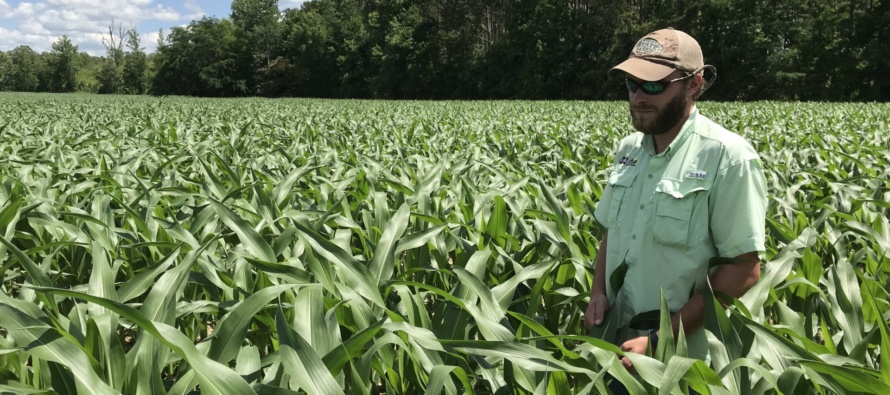Improving Corn Response to Nitrogen Fertilizer

Related Articles
- 2010 Soybean And Corn Variety Trial Data 3
- Fertilizing Cotton with Poultry Litter 5
- Spring Nitrogen Fertility Suggestions for Wheat 0
Latest Tweets
Nitrogen efficiency is certainly a hot topic this year due to extraordinary fertilizer prices. Of course, corn is a crop known to be very responsive to nitrogen fertilizer and needs large amounts to optimize productivity. However, nitrogen is also rather unstable compared to other nutrients and prone to considerable loss, especially in our high rainfall southern climate. Therefore, optimizing your crop response to nitrogen fertilizer will undoubtedly involve considerably more planning and management than simply applying a given fertilizer rate.
Mississippi’s warm, wet climate threatens considerable nitrogen loss over the course of a long corn growing season, which was evident last year in many cases. Thus, nitrogen management becomes considerably more difficult than selecting an appropriate fertilizer rate for a crop or yield goal. Our traditional standard is based upon a generous 1.3 pounds of N per bushel of corn grain yield, but management, environmental conditions and soils may all affect the outcome. Conversely, top corn yields can sometimes be realized with as little as 1.0 pound of N per bushel of grain yield. Therefore, employing strategies which minimize nitrogen loss are critical to optimize efficiency. In fact, our corn yields continue to increase, despite using similar nitrogen rates for the past 20 years in many instances.
The primary goal for improving corn response to nitrogen fertilizer should be to minimize nitrogen exposure to wet soils, while still meeting crop demand. Frequent rainfall greatly increases potential loss of nitrogen fertilizer applied to soils which remain wet and saturated for considerable time. Corn’s long growing season and supplemental irrigation may also compound nitrogen loss. Therefore, we can improve this dynamic by using multiple split applications of nitrogen fertilizer which supply what the crop needs, while reducing exposure to adverse weather which promote loss.
During early vegetative stages, corn nitrogen needs are very low, while rainfall is normally high. Therefore, applying only a small portion of total nitrogen near or shortly following emergence can greatly reduce your nitrogen exposure to unfavorable conditions promoting loss. Subsequent “split” or “topdress” applications should contain the bulk of the crop seasonal nitrogen needs.
For example, although corn doesn’t require much nitrogen during early vegetative growth stages, you need to apply a modest amount of about 30 to 60 lbs/a of nitrogen (10 – 20% of seasonal total) by the time it gets 4 to 6 inches tall, or slightly later if you applied a starter fertilizer. Corn begins rapid growth and nitrogen uptake at about the V5-6 growth stage. This is the key stage for your ground-applied nitrogen operation or side-dress application which supplies the bulk of seasonal crop needs. A practical goal for side-dressing or injecting liquid nitrogen is when corn reaches V4 – V6 growth stage (8 to 18 inches tall). A pre-tassel application can also be incorporated as simply another split to improve your efficiency. This component can be critical to producing high corn yields during wet seasons, as many found last year.
The figure below illustrates a suggested schedule for sidedressing nitrogen on corn. The green graph represents nitrogen uptake relative to corn growth and serves as a basis for optimal nitrogen timing. The numbers note the percentage of nitrogen applied at each specific timing. If you do not employ a pre-tassel application of urea, this portion of nitrogen can be applied in the sidedress application.
Top-dressing urea is also becoming more popular method for growers in the Midsouth. However, there are inherent drawbacks with this method that may increase risk, compared to the traditional side-dress method of injecting liquid nitrogen solution in the soil. Top-dressing urea requires rainfall or over-head irrigation to successfully incorporate nitrogen and prevent volatility loss. This can present issues, if we experience a lengthy dry spell encompassing key application time, which may happen at times during May. This is why reliance on top-dress urea fertilizer is not common in drier regions of the U.S. We strongly recommend using a urease inhibitor containing the active ingredient NBPT, such as Agrotain, Aborite AG, N-Veil, NITRAIN, NitroGain UI to limit volatility of top-dressed urea. Of course, timing urea application prior to forecast rainfall is suggested to help aid incorporation and reduce potential volatility. Additionally, avoid application to saturated or wet soils which promote loss. In order to minimize leaf burn associated with top-dress application, we generally suggest applying no more than 150 lbs/a of urea per application on corn more than three feet tall. Thus, multiple top-dress applications (usually 4 to 6) are required to meet total seasonal N demand. After the initial fertilizer is applied shortly after crop emergence, we suggest timing subsequent applications beginning at the V5 growth stage (12-inches tall).
This figure illustrates a suggested schedule for topdressing urea on corn. The green graph represents nitrogen uptake relative to corn growth and serves as a basis for optimal nitrogen timing. The numbers note the rate of nitrogen applied in individual applications. For example, 125 pounds of 41-0-0-4 per acre supplies 51 pounds of nitrogen per acre.






Let me tell You a sad story ! There are no comments yet, but You can be first one to comment this article.
Write a comment